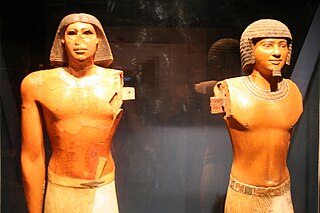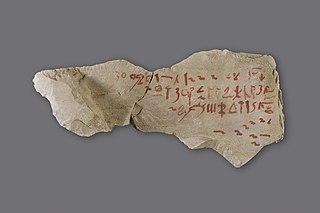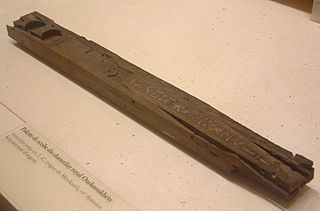Related Research Articles

The Great Hymn to the Aten is the longest of a number of hymn-poems written to the sun-disk deity Aten. Composed in the middle of the 14th century BC, it is varyingly attributed to the 18th Dynasty Pharaoh Akhenaten or his courtiers, depending on the version, who radically changed traditional forms of Egyptian religion by replacing them with Atenism. The hymn bears a notable resemblance to the biblical Psalm 104.

The Westcar Papyrus is an ancient Egyptian text containing five stories about miracles performed by priests and magicians. In the papyrus text, each of these tales are told at the royal court of king Khufu (Cheops) by his sons. The story in the papyrus usually is rendered in English as, "King Cheops and the Magicians" and "The Tale of King Cheops' Court". In German, into which the text of the Westcar Papyrus was first translated, it is rendered as Die Märchen des Papyrus Westcar.
The Teaching for King Merykara, alt. Instruction Addressed to King Merikare, is a literary composition in Middle Egyptian, the classical phase of the Egyptian language, probably of Middle Kingdom date.

Ptahhotep, sometimes known as Ptahhotep I or Ptahhotpe, was an ancient Egyptian vizier during the late 25th century BC and early 24th century BC Fifth Dynasty of Egypt. He is credited with authoring The Maxims of Ptahhotep, an early piece of Egyptian "wisdom literature" meant to instruct young men in appropriate behavior.
Djedi is the name of a fictional ancient Egyptian magician appearing in the fourth chapter of a story told in the legendary Westcar Papyrus. He is said to have worked wonders during the reign of king (pharaoh) Khufu.

Instruction of Amenemope is a literary work composed in Ancient Egypt, most likely during the Ramesside Period ; it contains thirty chapters of advice for successful living, ostensibly written by the scribe Amenemope son of Kanakht as a legacy for his son. A characteristic product of the New Kingdom "Age of Personal Piety", the work reflects on the inner qualities, attitudes, and behaviors required for a happy life in the face of increasingly difficult social and economic circumstances. It is widely regarded as one of the masterpieces of ancient near-eastern wisdom literature and has been of particular interest to modern scholars because of its similarity to the later biblical Book of Proverbs.

The Maxims of Ptahhotep or Instruction of Ptahhotep is an ancient Egyptian literary composition by the Vizier Ptahhotep around 2375–2350 BC, during the rule of King Djedkare Isesi of the Fifth Dynasty. The text was discovered in Thebes in 1847 by Egyptologist M. Prisse d'Avennes. The Instructions of Ptahhotep are considered didactic wisdom literature belonging to the genre of sebayt. There are four copies of the Instructions, and the only complete version, Papyrus Prisse, is located in the Bibliothèque Nationale in Paris. According to William Kelly Simpson, scholars tend to believe that the Instructions of Ptahhotep were originally composed during the Middle Kingdom, specifically the Twelfth Dynasty. The earliest extant copies of the text were altered to make them understandable for the Egyptians of the New Kingdom. The text presents a very good picture of the general attitudes of that period. The Instructions of Ptahhotep addresses various virtues that are necessary to live a good life and how to live accordingly to Maat, which was an important part of the Egyptian culture.

Instructions of Amenemhat is a short ancient Egyptian poem of the sebayt genre written during the early Middle Kingdom. The poem takes the form of an intensely dramatic monologue delivered by the ghost of the murdered 12th Dynasty pharaoh Amenemhat I to his son Senusret I. It describes the conspiracy that killed Amenemhat, and enjoins his son to trust no-one. The poem forms a kind of apologia of the deeds of the old king's reign. It ends with an exhortation to Senusret to ascend the throne and rule wisely in Amenemhat's stead.
Sebayt is the ancient Egyptian term for a genre of pharaonic literature. sbꜣyt literally means "teachings" or "instructions" and refers to formally written ethical teachings focused on the "way of living truly". Sebayt is considered an Egyptian form of wisdom literature.

The Prisse Papyrus is an ancient Egyptian papyrus datable to the Middle Kingdom which was discovered by the inhabitants of Kurna and given to French orientalist Émile Prisse d'Avennes at Thebes and published in 1847 and is now in the Bibliothèque nationale de France in Paris.
Inhabitants of Kurna originally found the papyrus inside the rishi coffin of pharaoh Sekhemre-Wepmaat Intef of the 17th Dynasty, whose tomb was probably located in Dra' Abu el-Naga' near Thebes.

The Satire of the Trades, also called The Instruction of Kheti, is a didactic work of ancient Egyptian literature. It takes the form of an instruction and was composed by a scribe from Sile named Kheti for his son Pepi. The Satire exalts the career of a scribe while remarking on the drudgery experienced in other professions. Laborers are described in the document as having tired arms and to be living in subpar conditions. This poor standard of living is juxtaposed with the life of a scribe, whose job is "greater than any profession". Egyptologists disagree on whether or not the text is satirical. The same Kheti may have composed the Instructions of Amenemhat, but this is unclear.

Ancient Egyptian literature was written with the Egyptian language from ancient Egypt's pharaonic period until the end of Roman domination. It represents the oldest corpus of Egyptian literature. Along with Sumerian literature, it is considered the world's earliest literature.
The Instruction of Any, or Ani, is an Ancient Egyptian text written in the style of wisdom literature which is thought to have been composed in the Eighteenth Dynasty of the New Kingdom, with a surviving manuscript dated from the Twenty-First or Twenty-Second Dynasty. Due to the amount of gaps and corruption it has been considered a difficult, and at times obscure, text to translate.

Harper's Songs are ancient Egyptian texts that originated in tomb inscriptions of the Middle Kingdom, which in the main praise life after death and were often used in funerary contexts. These songs display varying degrees of hope in an afterlife that range from the skeptical through to the more traditional expressions of confidence. These texts are accompanied by drawings of blind harpists and are therefore thought to have been sung. Thematically they have been compared with The Immortality of Writers in their expression of rational skepticism.
The Immortality of Writers is an Ancient Egyptian wisdom text likely to have been used as an instructional work in schools. It is recorded on the verso side of the Chester Beatty IV papyrus held in the British Museum. It is notable for its rationalist skeptical outlook, even more emphatic than in the Harper's Songs, regarding an afterlife. The scribe advises that writings of authors provide a more sure immortality than fine tombs. The text is dated to the transition period between the 19th Dynasty and the 20th Dynasty.
...Those writers known from the old days, the times just after the gods. Those who foretold what would happen, whose names will endure for eternity. They disappeared when they finished their lives, and all their kindred forgotten. They did not build pyramids in bronze with gravestones of iron from heaven. They did not think to leave a patrimony made of children who would give their names distinction, rather they formed a progeny by means of writing and in the books of wisdom they left...
They gave themselves [the scroll as lector]-priest, the writing board as loving son. Instruction are their tombs, the reed pen their child, the stone surface their wife..... Man decays, his corpse is dust. All his kin have perished; But a book makes him remembered through the mouth of its reciter. Better is a book than a well built house...
The Instructions of Kagemni is an ancient Egyptian instructional text of wisdom literature which belongs to the sebayt ('teaching') genre. Although the earliest evidence of its compilation dates to the Middle Kingdom of Egypt, its authorship has traditionally yet dubiously been attributed to Kagemni, a vizier who served during the reign of the Pharaoh Sneferu (r. 2613–2589 BC), founder of the Fourth Dynasty.

Merikare was an ancient Egyptian pharaoh of the 10th Dynasty who lived toward the end of the First Intermediate Period.
Purportedly inspired by the teaching of his father, he embarked on a semi-peaceful coexistence policy with his southern rivals of the 11th Dynasty, focusing on improving the prosperity of his realm centered on Herakleopolis instead of waging an open war with Thebes. His policy was not rewarded, and shortly after his death his kingdom was conquered by the Theban Mentuhotep II, marking the beginning of the Middle Kingdom. The existence of his pyramid has historically been ascertained, although it has not yet been discovered.
Baufra is the name of an alleged son of the ancient Egyptian king (pharaoh) Khufu from the 4th Dynasty of the Old Kingdom. He is known from a story in the Papyrus Westcar and from a rock inscription at Wadi Hammamat. He is neither contemporarily nor archaeologically attested, which makes his historical figure disputable to scholars up to this day.

Insinger Papyrus is a papyrus find from ancient Egypt and contains one of the oldest extant writings about Egyptian wisdom teachings (Sebayt). The manuscript is dated to around the 1st century BC according to the Rijksmuseum van Oudheden in Leiden where the main part is kept. Other sources suggest it dates to the 1st century AD, and to the 3rd century BC. Fragments have also been found in other collections.
References
- Lichtheim, Miriam, Ancient Egyptian Literature, Volume I, 1973, pp. 58f.
- ↑ "Teaching of Hordjedef". Staatliches Museum Ägyptischer Kunst.
- ↑ Ian Shaw, The Oxford History of Ancient Egypt, Oxford University Press 2003, p.90
- ↑ Donald Mackenzie, Egyptian Myth and Legend, 1907, pp.246f.
- ↑ Katheryn A. Bard, Encyclopedia of the Archaeology of Ancient Egypt, Routledge 1999, p.41